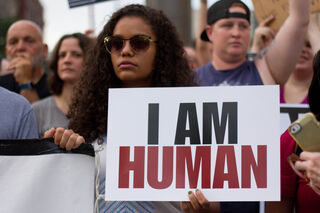Bias
The Dehumanizing Mind
How and why we think of others as less than human.
Posted July 10, 2020 Reviewed by Devon Frye

Anyone who studies mass violence will sooner or later be confronted with the phenomenon of dehumanization. People use the word “dehumanization” in a bewilderingly wide variety of ways, but I use it to mean the belief that some group of people are really subhuman creatures.
It’s well known that the Nazis thought of Jews as Untermenschen (“subhumans”) fit to be exterminated, and that many White Americans have thought of Black men as monstrous predators. It is less well known that vicious attacks the Muslim minority in Myanmar by militant Buddhists, and the persecution of Romani people in Central Europe, are also fueled by poisonous dehumanizing rhetoric.
Dehumanization is intimately bound up with the worst atrocities that human beings have perpetrated against one another. It haunts the episodes of genocide, war, and racial oppression that deface our history. That’s why dehumanization needs urgently to be understood, and why I have been studying it for the past decade.
During that time, I have reached some definite conclusions about exactly what dehumanization is, how it works, and what its function is. I’ve set out these ideas in my most recent book, On Inhumanity: Dehumanization and How to Resist It, which was published earlier this month by Oxford University Press, and I want to discuss them here. (Of course, I can’t give you a detailed description of my findings in the limited space of a blog posting, but I can talk to you about some of the book’s major points.)
First, dehumanization is neither wholly psychological nor wholly political. It is a psychological response to political forces. Dehumanizing beliefs do not arise spontaneously within the human mind. They are inculcated by propaganda. So, any adequate theory of dehumanization needs to encompass both the psychological and political dimensions of it. A purely political theory can’t explain how dehumanizing propaganda affects human behavior, and a purely psychological theory can’t explain where dehumanizing beliefs come from.
Second, dehumanization is intertwined with racism (as I put it in the book, dehumanization is “racism on steroids”). Groups of people are almost always thought of as a separate race—a fundamentally different and inherently inferior kind of human being—as a prelude to being dehumanized. Dehumanization then takes this derogation a step further by insisting that these people are not really human at all.
Third, dehumanizing propaganda exploits some of our cognitive biases to get us to conceive of others as less than human. One of these is known as psychological essentialism, which is basically our tendency to think that what makes a living thing a particular kind of living thing is something deep inside of it rather than its superficial appearance.
Psychological essentialism is crucial for making sense of dehumanization because it allows that a thing’s appearance can belie its essence. From the essentialist perspective, how an entity looks can mislead us about its true nature. An individual might seem human on the “outside”—they might walk, and talk, and act like a human—and yet be subhuman on the “inside.” It’s a recurring theme that although the members of a marginalized group resemble human beings, they are not truly human. They are, so to speak, counterfeit human beings.
Another bias that underpins dehumanization is the tendency to hierarchical thinking—the disposition to think of some kinds of being as being “higher,” and therefore as having greater intrinsic value, than other kinds of being. This way of thinking is what makes notions of superiority and inferiority possible, and it lies behind both racism (seeing others as lesser humans) and dehumanization (seeing others as less than human).
Fourth, dehumanization has the function of disabling inhibitions against violence. There’s an important reason why we need dehumanization (and also other methods) to help us do terrible things to one another. Homo sapiens are ultrasocial animals. There is no other mammal that comes anywhere close to our intense sociality. Like all social animals, we must inhibit aggression against fellow community members, because otherwise, social life would not be possible. For non-human animals, these instinctive restraints are mostly limited to the local breeding group. But in our species—thanks to our ultrasociality—they also embrace outsiders.
These inhibitions against acts of violence create a problem for human beings, because we are also able to recognize that it can be advantageous for us to do violence to our neighbors: to enslave them, to exterminate them, to oppress them, and so on. Consequently, over the millennia, we have developed cultural technologies for disabling and overriding inhibitions against acts of violence. The use of dehumanizing propaganda is one of these methods.
Finally, despite the power of dehumanizing rhetoric, it is very difficult for us to completely shake the idea that others are human beings. Because of our ultrasocial nature, evolution has primed us to automatically “see human” when we encounter other members of our own species. We are exquisitely attuned to the humanness of others. And therein lies a problem. Paradoxically, it is our inability to close our eyes to the humanity of others that leads to the most destructive forms of dehumanization.
Here is what happens. Dehumanizers accept that a specific group of people—Jews, Blacks, Roma, or whomever—are really subhuman beasts. But they also can’t help seeing these others as fellow human beings. This sets up a very dangerous tension in the dehumanizing mind, because the dehumanized others are seen as human and subhuman simultaneously. This weird combination goes beyond transforming them into subhuman animals. It turns them into horrifying monsters.
I hope that this essay has piqued your interest, and that it will move you to look more deeply into the phenomenon of dehumanization. Without a clear understanding of the forces that drive the dehumanizing process, we do not stand much of a chance of doing anything about it. Without such knowledge, we may be setting humanity up for the next Auschwitz, for the Srebrenica massacre, for the next Rwanda genocide.
References
Smith, D. L (2020). On Inhumanity: Dehumanization and How to Resist It. New York: Oxford University Press.




